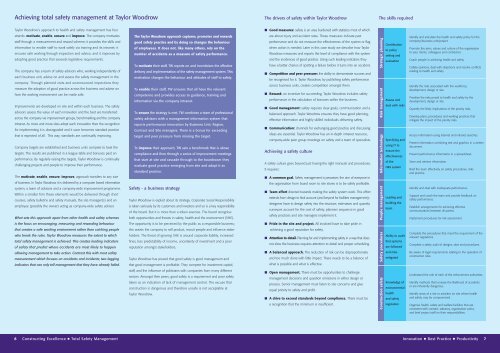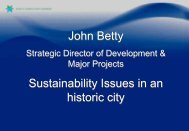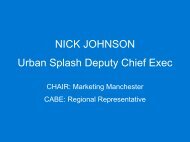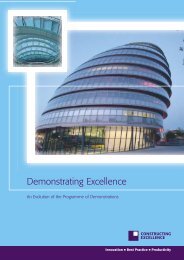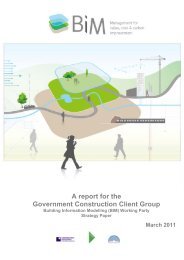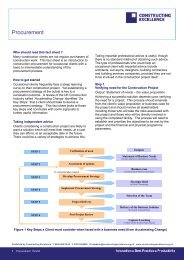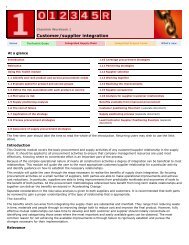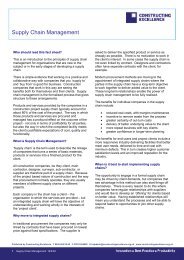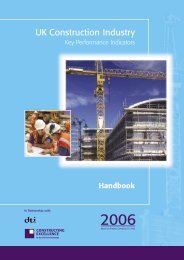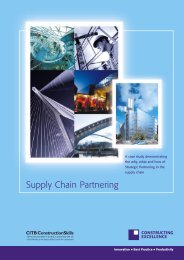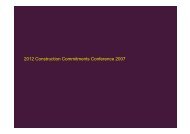Total Safety Management Taylor Woodrow - Constructing Excellence
Total Safety Management Taylor Woodrow - Constructing Excellence
Total Safety Management Taylor Woodrow - Constructing Excellence
You also want an ePaper? Increase the reach of your titles
YUMPU automatically turns print PDFs into web optimized ePapers that Google loves.
Achieving total safety management at <strong>Taylor</strong> <strong>Woodrow</strong><br />
The drivers of safety within <strong>Taylor</strong> <strong>Woodrow</strong><br />
The skills required<br />
<strong>Taylor</strong> <strong>Woodrow</strong>’s approach to health and safety management has four<br />
■ Good measures: safety is an area burdened with statistics most of which<br />
strands: motivate, enable, ensure and improve. The company motivates<br />
staff through a measurement and reward scheme; it provides the skills and<br />
information to enable staff to work safely via training and its intranet; it<br />
ensures safe working through inspection and advice; and it improves by<br />
adopting good practice that exceeds legislative requirements.<br />
The company has a team of safety advisors who, working independently of<br />
each business unit, advise on and assess the safety management in the<br />
company. Through planned visits and unannounced inspections they<br />
measure the adoption of good practice across the business and advise on<br />
how the working environment can be made safe.<br />
Improvements are developed on site and within each business. The safety<br />
advisors assess the value of each innovation and the best are transferred<br />
across the company via improvement groups, benchmarking and the company<br />
intranet. As more and more sites adopt each innovation then the recognition<br />
for implementing it is downgraded and it soon becomes standard practice<br />
that is expected of all. This way, standards are continually improving.<br />
Company targets are established and business units compete to beat the<br />
targets. The results are published in a league table and bonuses paid on<br />
performance. By regularly raising the targets, <strong>Taylor</strong> <strong>Woodrow</strong> is continually<br />
challenging projects and people to improve their performance.<br />
The motivate, enable, ensure, improve, approach transfers to any size<br />
of business. In <strong>Taylor</strong> <strong>Woodrow</strong> it is delivered by a computer based information<br />
system, a team of advisors and a company-wide improvement programme.<br />
Within a smaller firm these elements would be delivered through short<br />
courses, safety bulletins and safety manuals, the site manager(s) and an<br />
employee (possibly the owner) acting as company-wide safety advisor.<br />
What sets this approach apart from other health and safety schemes<br />
The <strong>Taylor</strong> <strong>Woodrow</strong> approach captures, promotes and rewards<br />
good safety practice and by doing so changes the behaviour<br />
of employees. It does not, like many others, rely on the<br />
number of accidents as a measure of safety performance.<br />
To motivate their staff, TW reports on and incentivises the effective<br />
delivery and implementation of the safety management system. This<br />
motivation changes the behaviour and attitudes of staff to safety.<br />
To enable their staff, TW ensures that all have the relevant<br />
competence and provides access to guidance, training and<br />
information via the company intranet.<br />
To ensure the strategy is met, TW combines a team of professional<br />
safety advisors with a management information system that<br />
reports performance innovation by Business Unit, Region,<br />
Contract and Site managers. There is a bonus for exceeding<br />
target and peer pressure from missing the target.<br />
To improve their approach, TW sets a benchmark that is above<br />
compliance and then through a series of improvement meetings<br />
that start at site and cascade through to the boardroom they<br />
evaluate good practice emerging from site and adopt it as<br />
standard practice.<br />
<strong>Safety</strong> - a business strategy<br />
<strong>Taylor</strong> <strong>Woodrow</strong> is explicit about its strategy. Corporate Social Responsibility<br />
is taken seriously by its customers and investors and so is a key responsibility<br />
of the board. But it is more than a token exercise. The board recognise<br />
both opportunities and threats in safety, health and the environment (SHE).<br />
are about injury and accident rates. These measures indicate past<br />
performance and do not measure the effectiveness of the system or flag<br />
when action is needed. Later in this case study we describe how <strong>Taylor</strong><br />
<strong>Woodrow</strong> measures and reports the level of compliance with the system<br />
and the incidences of good practice. Using such leading indicators they<br />
have a better chance of spotting a failure before it turns into an accident.<br />
■ Competition and peer pressure: the ability to demonstrate success and<br />
be recognised for it. <strong>Taylor</strong> <strong>Woodrow</strong>, by publishing safety performance<br />
across business units, creates competition amongst them.<br />
■ Reward: an incentive for succeeding. <strong>Taylor</strong> <strong>Woodrow</strong> includes safety<br />
performance in the calculation of bonuses within the business.<br />
■ Good management: safety requires clear goals, communication and a<br />
balanced approach. <strong>Taylor</strong> <strong>Woodrow</strong> ensures they have good planning,<br />
effective information and highly skilled individuals delivering safety.<br />
■ Communication: channels for exchanging good practice and discussing<br />
ideas are essential. <strong>Taylor</strong> <strong>Woodrow</strong> has an in-depth intranet resource,<br />
company-wide peer group meetings on safety and a team of specialists.<br />
Achieving a safety culture<br />
A safety culture goes beyond just having the right manuals and procedures.<br />
It requires:<br />
■ A common goal. <strong>Safety</strong> management is pervasive; the aim of everyone in<br />
the organisation from board room to site stores is to be safely profitable.<br />
■ Team effort directed towards making the safety system work. This effort<br />
extends from design to final account (and beyond for facilities management);<br />
designers have to design safety into the structure, estimators and quantity<br />
surveyors account for the cost of safety, planners sequence in good<br />
safety practices and site managers implement it.<br />
People management Information technology Risk management<br />
Strategic planning<br />
Contribution<br />
to policy<br />
setting and<br />
evaluation<br />
Assess and<br />
deal with risks<br />
Specifying and<br />
using IT to<br />
ensure the<br />
effectiveness<br />
of the<br />
H&S system<br />
Leading and<br />
building the<br />
team<br />
Identify and articulate the health and safety policy for the<br />
company/business unit/project.<br />
Promote the aims, values and culture of the organisation<br />
to your clients, colleagues and contractors.<br />
Coach people in achieving health and safety.<br />
Collate opinions, deal with objections and resolve conflicts<br />
relating to health and safety.<br />
Identify the risks associated with the workforce,<br />
development, design or site.<br />
Prioritise the risks posed to health and safety by the<br />
development, design or site.<br />
Quantify the likely implications of the priority risks.<br />
Develop plans, procedures and working practices that<br />
mitigate the impact of the priority risks.<br />
Access information using internet and intranet searches.<br />
Present information combining text and graphics in a written<br />
document.<br />
Present performance information in a spreadsheet.<br />
Store and retrieve information.<br />
Brief the team effectively on safety procedures, risks<br />
and practice.<br />
Identify and deal with inadequate performance.<br />
Support and coach the team and provide feedback on<br />
safety performance.<br />
Establish arrangements for achieving effective<br />
communications between all parties.<br />
Implement procedures for risk assessment.<br />
is the focus on encouraging, measuring and rewarding behaviour<br />
The opportunity is to be perceived by the public as a responsible business;<br />
■ Pride in the site and project. All involved have to take pride in<br />
that creates a safe working environment rather than catching people<br />
who break the rules. <strong>Taylor</strong> <strong>Woodrow</strong> measures the extent to which<br />
total safety management is achieved. This creates leading indicators<br />
of safety that predict where accidents are most likely to happen<br />
allowing management to take action. Contrast this with most safety<br />
measurement which focuses on accidents and incidents; two lagging<br />
indicators that can only tell management that they have already failed.<br />
this assists the company to sell product, recruit people and influence stakeholders.<br />
The threat of ignoring SHE is around corporate liability, increased<br />
fines, less predictability of income, uncertainty of investment and a poor<br />
reputation amongst stakeholders.<br />
<strong>Taylor</strong> <strong>Woodrow</strong> has proved that good safety is good management and<br />
that good management is profitable. They compete for investment capital,<br />
achieving a good reputation for safety.<br />
■ Attention to detail. Planning for and implementing safety in a way that does<br />
not slow the business requires attention to detail and proper scheduling.<br />
■ A balanced approach. The reduction of risk can be disproportionate<br />
and too much done with little impact. There needs to be a balance of<br />
what is possible and what is effective.<br />
<strong>Safety</strong> procedures<br />
Ability to audit<br />
that systems<br />
are followed<br />
and risks<br />
mitigated<br />
Complete the procedures that meet the requirement of the<br />
relevant regulations.<br />
Complete a safety audit of designs, sites and procedures.<br />
Be aware of legal requirements relating to the operation of<br />
construction sites.<br />
staff, and the influence of politicians with companies from many different<br />
sectors. Amongst their peers, good safety is a requirement and poor safety<br />
taken as an indication of lack of management control. The excuse that<br />
construction is dangerous and therefore unsafe is not acceptable at<br />
<strong>Taylor</strong> <strong>Woodrow</strong>.<br />
■ Open management. There must be opportunities to challenge<br />
management decisions and question omissions in either design or<br />
process. Senior management must listen to site concerns and give<br />
equal priority to safety and profit.<br />
■ A drive to exceed standards beyond compliance. There must be<br />
a recognition that the minimum is insufficient.<br />
Construction safety<br />
Knowledge of<br />
environmental<br />
health<br />
and safety<br />
legislation<br />
Understand the role of each of the enforcement authorities.<br />
Identify methods that increase the likelihood of accidents<br />
or are inherently dangerous.<br />
Identify areas of a site or activities on site where health<br />
and safety may be compromised .<br />
Organise health, safety and welfare facilities that are<br />
consistent with contract, statutory, organisation policy<br />
and brief project staff on their responsibilities.<br />
6 <strong>Constructing</strong> <strong>Excellence</strong> ■ <strong>Total</strong> <strong>Safety</strong> <strong>Management</strong><br />
Innovation ■ Best Practice ■ Productivity 7


